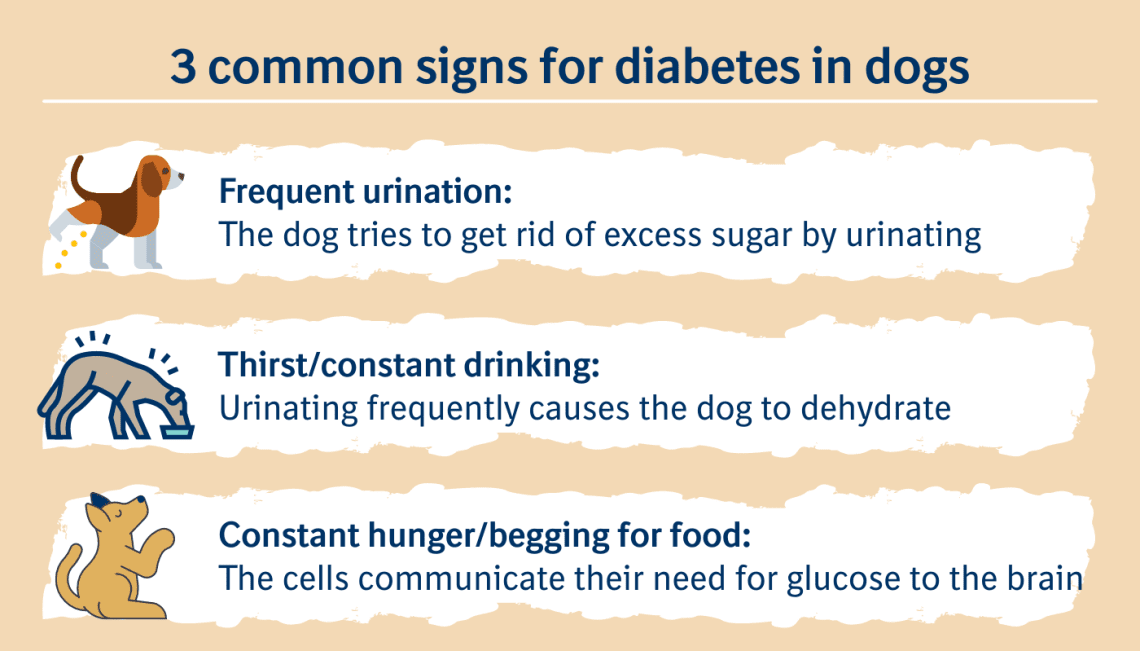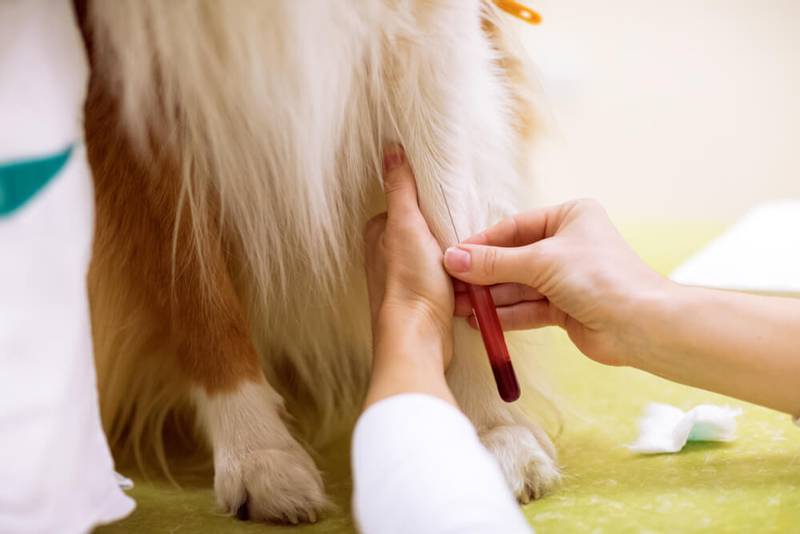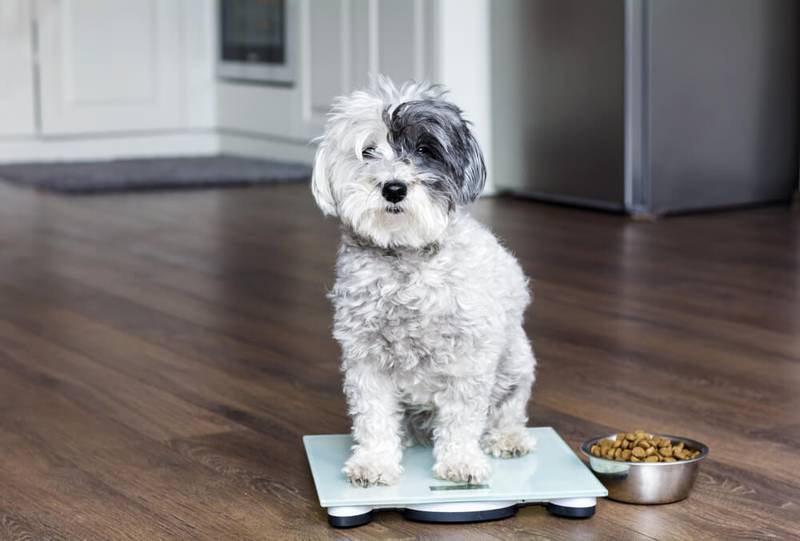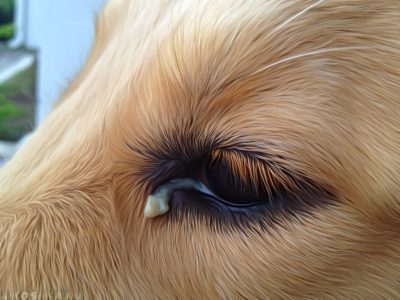
Diabetes in dogs

Diabetes affects not only people, but also their pets. If your four-legged friend has become lethargic, constantly thirsty and refuses his favorite treats, this is an occasion to take him to the veterinarian. With a timely visit to the doctor, the condition of an animal diagnosed with diabetes can be corrected, which will help your pet live a long life.
Contents
Diabetes in Dogs: Essentials
There are two forms of diabetes: type 1 (insulin-dependent) and type 2 (insulin-independent), the latter is extremely rare in dogs;
The main symptoms of the disease include frequent urination, increased thirst, increased appetite, pet weight loss and lethargy.
The diagnosis is made by measuring the level of sugar in the blood and urine.
The main methods of treatment include the introduction of insulin and the use of a special diet.
Most often, diabetes affects dogs in middle or advanced age.

Causes of the disease
The causes of diabetes in dogs are still not fully understood. It is believed that genetic predisposition, viral infections, autoimmune disorders play a role in the development of the disease. The disease may appear due to a severe form of pancreatitis, neoplasms, trauma to the pancreas, endocrinological pathologies: for example, if the animal has Cushing’s syndrome. In bitches, the development of diabetes mellitus occurs against the background of estrus.
Diabetes symptoms
As a rule, the early manifestations of the disease do not go unnoticed by the owners, because the main symptoms of diabetes in dogs include increased thirst and frequent urination. Pets can no longer endure 12 hours between walks and begin to relieve themselves at home. Also, owners may note an increased appetite, while the animal begins to lose weight. However, pets with diabetes are often severely obese, and therefore the first signs of weight loss go unnoticed by the owners.
Later signs of the development of diabetes mellitus in dogs include severe lethargy and drowsiness, which are caused by increasing intoxication of the body. It is quite common for dogs to develop cataracts.
Diagnostics
Diabetes is diagnosed by measuring sugar in the blood and urine. Usually, first of all, at the reception, they take a drop of blood from the ear and determine the glucose level using a conventional glucometer – if results of more than 5 mmol are found, in-depth diagnostics begin. A urine test is mandatory – a healthy pet should not have glucose in the urine, its presence confirms the disease. An advanced biochemical blood test can detect the presence of associated health problems, and a complete blood count can show the presence of anemia and inflammation.
It is worth noting that with a pronounced stress state in the clinic, some pets may have an increased amount of sugar in the blood, which is not always a symptom of diabetes. In such cases, it is recommended to measure glucose at home and be sure to collect urine for analysis in calm conditions.
An additional test to confirm the diagnosis is the measurement of fructosamine in the blood, a protein that transports glucose in the body. This study also helps to distinguish the increase in glucose levels against the background of stress from the true disease.

Diabetes treatment
In the development of type 1 diabetes in dogs, lifelong insulin therapy is used. An important factor in successful treatment is the initial selection of the drug and its dose, therefore, when the first signs of the disease are detected, it is recommended to place the pet in a hospital.
Insulin of the first choice are medium-acting drugs, such as the veterinary drug “caninsulin” or the medical “levemir” and “lantus”. These drugs are administered to the pet 2 times a day with an interval of 11-12 hours between injections.
To select the dose of the drug, glucose measurements are taken before insulin administration, then 6 hours after. Further – before the evening injection for several days. The owner then independently monitors their pet’s blood glucose levels using a home glucometer.
If diabetes develops in a bitch during estrus, the disease is usually reversible with timely spaying.
If a pet has rare type 2 diabetes, hypoglycemic drugs are used.
In addition, it is recommended to adhere to a specialized diet and exercise. If the pet is obese, gradual weight loss to the ideal weight within 2-4 months is recommended.
Dining with diabetes
Diet plays an important role in maintaining a good quality of life for your pet and preventing deterioration. Specialized foods such as Royal Canin Diabetic, Hill’s w/d or Farmina Vet Life Diabetic are used as nutrition for sick dogs. These diets are assigned to pets for life.
With a natural diet, the restriction of simple sugars is applied by adding complex carbohydrates to the diet; moderate amount of protein; fairly low fat content in the diet. To make a home diet, it is recommended to consult with a nutritionist so that the food is balanced. You can do this online in the Petstory mobile application. You can download it from the link.

Prevention
It has been proven that obesity can be a predisposing factor in the development of diabetes in dogs, so weight control of the pet plays an important role in preventing the disease. It is very important to feed the dog with a balanced diet in accordance with its physiological needs, to minimize the number of treats from the table. Sweets, buns, biscuits are categorically unacceptable in the diet of dogs.
Active walks also play an important role in the prevention of the disease, since physical activity not only allows you to reduce weight, but also helps to reduce blood sugar levels.
Remember that the disease is always easier to prevent than to cure. Therefore, proper nutrition, active leisure and timely examinations at the veterinarian will help keep your pet healthy for many years.
August 5 2021
Updated: September 16, 2021





